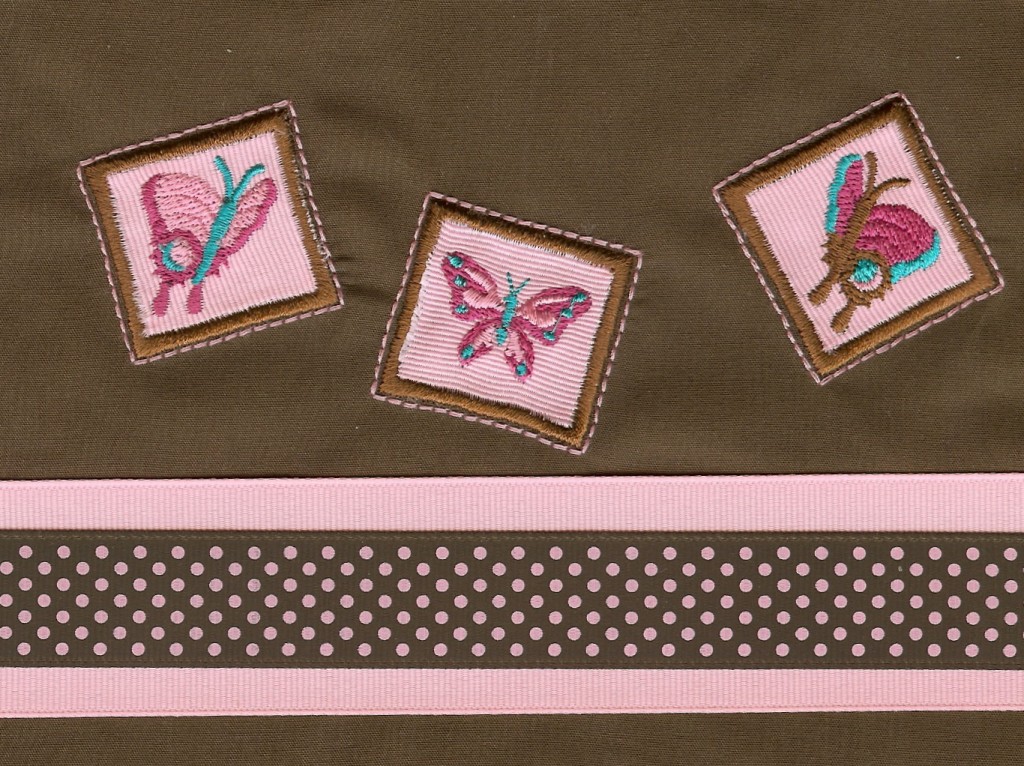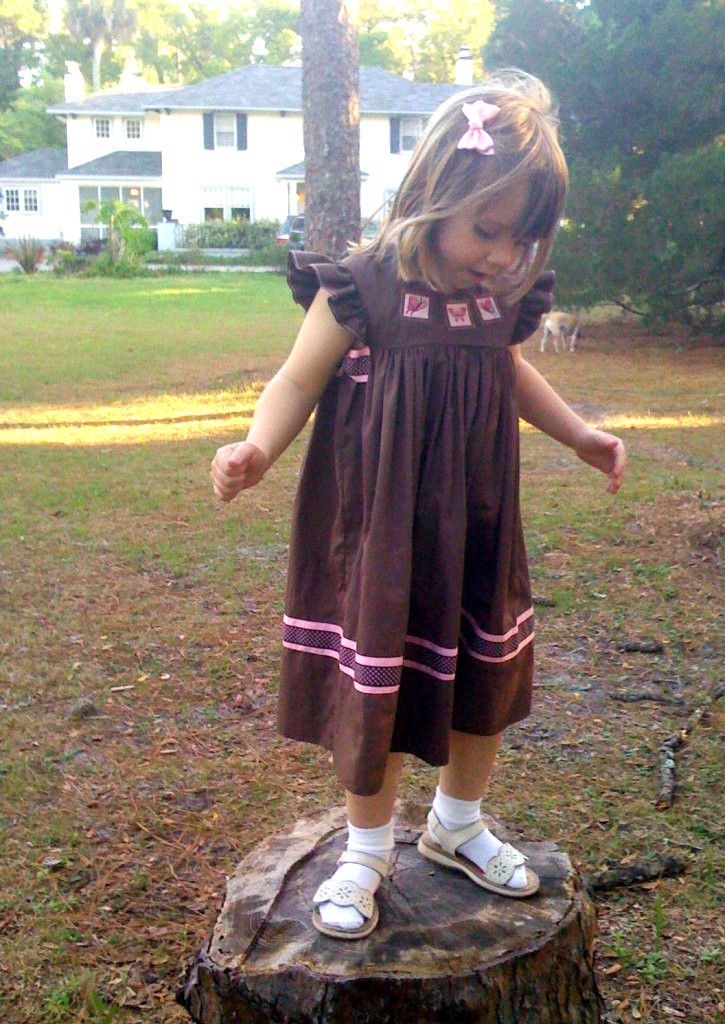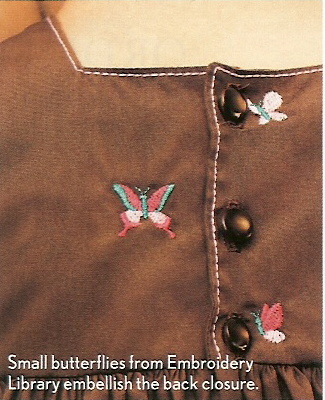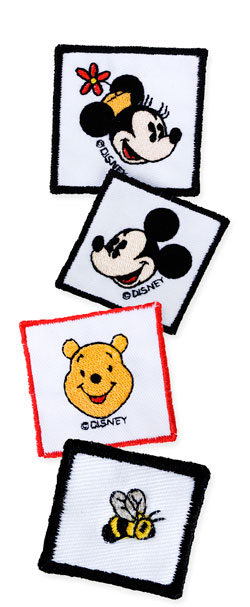
Laurel in stamps dress, Robert in rocket shirt. He thinks he got the better deal. A strip of that skirt fancyband ribbon, measuring the exact width of the armhole, has been stitched down at either end of the casing. The ribbon is simply whipped with thread in the center and tacked through the elastic and casing. This gives the illusion of a bow.
“Stamps” are quick and easy machine embroidery embellishments for anything from baby knits to adult clothing. Somehow, photos of my “stamped” pink onesie and hat have disappeared. But you can trust me when I tell you it was very, very cute. And quick and easy.
For readers, machine embroidery design for these little squares are free and available in three sizes: 1-1/2″, 1-3/4″ and 2 1/2″. You simply insert a design small enough to fit into that square. Also included is one stamp with a bumblebee.
This is one of Laurel’s favorite dresses. She loves the butterfly “stamps” and I like the versatility of the sundress/jumper pattern, Hanna by Collars, Etc. It can be smocked or not.
If you would like these designs (a set of four), simply leave a comment with your request and I will e-mail them to you. Unless requested, the designs will be in .pes format. Let me know if you need another or have trouble converting.
Then you will be a stamp collector!
A strip of that same ribbon, measuring the exact width of the armhole, has been stitched down at either end of the underarm casing for elastic. The ribbon is simply whipped with thread in the center, mimicking the knot of a bow, and tacked through the elastic and casing. This gives the illusion of a bow.
Made from brown Imperial broadcloth, the neckline and shoulder ruffle are edge stitched with pink thread. Stitched on top of wide pink grosgrain ribbon is a brown grosgrain with pink polka dots.
The design concept of “stamps” came from Dianne Boney, associate editor and contributor to Creative Needle magazine.
Intrigued by a baby dress she had purchased, her creative juices began to flow. The dress featured little applique’ squares, literally the size of postage stamps, embroidered with even tinier flowers scattered on the bodice of the newborn size frock.
Laurel’s brown dress and a few other projects were stitched for a Creative Needle article, inspired by Dianne, written by me and the bulk of which is included below.
If you would like to try some stamps, I would be happy to e-mail the design files mentioned in the article. Just send your request in the comment section.
Stamp a bit of playful machine embroidery on your next project for quick and easy personalization. Much like postage stamps which feature subjects from Elvis to famous artwork, there is no limit to what can be centered in the embroidered frames. By using software such as PE-Design and BuzzEdit2, miniature designs are imported to the applique’ square design files.
Stamp of Identification
Though embroidering a child’s name on a cap or ballet bag may seem like a good idea to prevent loss, doing so creates a security risk. By rather assigning a frog or even a Disney character to a youngster, a distinguishing stamp can be attached to his gear that is nearly as specific as a name. Additionally, that youngster’s mittens, scarvbes or athletic bag can be readily identified in a pile of similar items.
Stamp of Individuality
Transform any unembellished item–plain shirt, purse, placement or whatever-into something that reflects your personality or favorites. In no time at all, embroidered stamps can elevate” ready made” to “specially made.” Dinosaur stamps on bath towels will please a junior paleontologist. Little Disney fans will be delighted with Mickey, Minnie, Winnie the Pooh or other character patches on pj’s or simple tee shirts. Baby aviator patches scattered on infant items can match a nursery them. It will also bring a smile to his pilot daddy’s face.
Stamp of Rememberance
Many years ago, my creative friend Suzanne Sawko digitized a unique “love bug” which she embroidered in every item she made for her first grandchild. Often it was hidden in a pocket or under a collar. He delighted in searching for this tender reminder of his Mamaw’s affection.
With all the tiny designs available today, digitizing suitably sized embroidery is unnecessary. Simply select one heart or butterfly or whatever and embroider it somewhere on each gift to a grandchild, even if it is hidden in the hem or lining of a garment.
How to Select a Design
Collections of miniature designs are available from many sources. Those used on the butterfly stamp dress are from Things with Wings collection by Embroidery Library www.emblibrary.com
Tiny elements also can be extracted from larger designs. The smaller butterflies on the back of the brown sundress have been extracted from Embroidery Library’s butterfly buttonholes designs, available individually or as part of Nature’s Buttonholes design pack.
- #1 appliqué straight stitch outline on stabilizer
- #2 appliqué placement, straight stitched over appliqué fabric
- #3 repeat of #2, appliqué placement, after which fabric is trimmed
- #4 satin stitch frame
- #5 triple straight stitch around satin stitch frame.
Simply import the selected design into the best fitting stamp file between color stop #2 and #3. With the addition of the miniature design, the stamp file numbers will change.
Two stamp techniques are detailed below.
A. appliqué stamps machine embroidered directly onto garment
Using the available by request design files, embroider the stamp as any appliqué.
-
1. Iron on a stabilizer such as Firm Hold. Hoop fabric. If the item is difficult or impossible to hoop due to its size or shape, hoop a sticky stabilizer. Place the item to be embroidered on the stabilizer and proceed as if it were hoped.
- 2. Stitch color #1, a square outline, which indicates placement for the appliqué fabric. Use thread that matches the appliqué’ fabric.
- 3. Place appliqué’ fabric over outline. Stitch color #2, which repeats the outline of color #1.
- 4. Proceed to the first color of the miniature design. Complete the design.
- 5. Stitch color #3 of the stamp file using thread that matches the appliqué fabric . This will stitch out the original outline of the square. There may be a discrepancy between the two lines due to distortion from the embroidery
- 6. Remove hoop from machine but do not remove the stabilizer and fabric from the hoop. Place hoop on flat surface and trim excess fabric to the color #3 outline. NOTE: Cutting the fabric to the color #2 outline might put the raw edge inside the frame. Repeating this outline with color #3 after the miniature design is embroidered insures that the trimmed, raw edge of the appliqué’ fabric will fall inside the satin stitch frame.
- 7. Return hoop to machine and stitch color #4, the satin stitch square.
- 8. Stitch color #5, a triple stitch surrounding the satin stitch square. This mimics the perforations of a stamp.
-
1. Hoop two layers of a very sturdy water soluble stabilizer, such as Sulky’s Ultra Solvy.
-
2. Stitch color #1, appliqué placement, on stabilizer only. Use thread to match the color of the foundation fabric (top layer if using two).
-
3. Place foundation fabric over stitched outline. With same thread, stitch color #2 through fabric and stabilizer.
-
4. Proceed to the first color of the imported miniature design. Complete the miniature design.
-
5. Stitch color #3 of the stamp file. This will repeat the original outline of the square. There may be a discrepancy between the two outlines due to distortion from the embroidery.
-
6. Remove hoop from machine but do not remove the stabilizer and fabric from the hoop. Place hoop on flat surface and trim excess fabric to the color #3 outline. NOTE: Cutting the fabric to the color #2 outline might leave the raw edge exposed inside the frame, rather than enclosed in the satin stitch. Repeating that outline with color #3 after the miniature design is embroidered insures that the trimmed, raw edge of the appliqué fabric will fall inside the satin stitch.
-
7. Return hoop to machine and stitch color #4, the satin stitch square. Omit color #5, the triple stitch around the satin stitch square.
The free standing stamp/patch is now complete. Gently tear away from water soluble stabilizer and attach with zig zag stitch (L 1.0 W. 3.5) using matching or monofilament thread.
For the perforation effect of color #5, a triple straight stitch can be worked around the newly attached stamp. On the Brother Innov-is 4500D Duetta, use stitch #105, L. 3.0.







17 responses to “Stamps~Re-post”